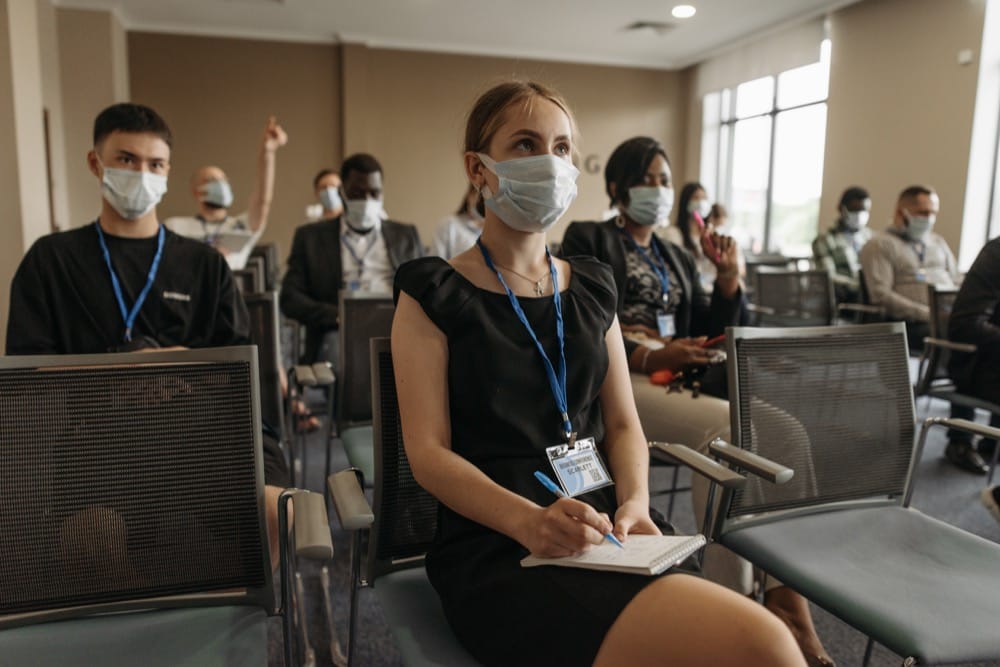When can we stop wearing masks?
Honestly if we want to reduce the impact of COVID, wearing masks indoors when in mixed groups may need to become the norm for years. Or maybe rapid tests will get even faster and you'll be able to blow into a breathalyzer on the way into a venue...

(I see this question come up a lot, here's my answer)
Honestly if we want to reduce the impact of COVID, wearing masks indoors when in mixed groups may need to become the norm for years. Or maybe rapid tests will get even faster and you'll be able to blow into a breathalyzer on the way into a venue, or you'll be able to lick a paper strip -or something- before access.
The first major cholera pandemic lasted ten years.
It would help if governments were leading the way improving infrastructure, and providing guidance on how to keep people safer. At this point it seems unlikely those plastic walls that sprung up everywhere have actually done any good (and maybe made things worse). HEPA filters on the other hand do a great job of pulling COVID out of the air they get a chance to filter. Putting a HEPA filter in key areas throughout an indoor restaurant is going to result in a much safer environment than turning your outdoor patio into a completely enclosed space with vinyl, plywood and 2x4s (and no ventilation).
Letting indoor spaces that have been able to improve their ventilation to meet some standard before places that haven't would make a lot of sense. Those places would be demonstrably safer. Clearly we should actually get public schools up to that standard.
So the question turns into: Is it worth it?
When we ask if something is "worth it" we're generally able to make an individual decision about what we'll receive, and what we'll pay. I think the Proof Burger is worth $20+tax+tip. You might not. But we're both able to look at what we're getting, and what we're paying to make that decision.
With COVID we know what the cost of fighting it is: masks, booster shots, vaccine passports, closing indoor-dining and bars, schools going online, maybe even closing all non-essential workplaces.
We know some of what we're getting for all those measures. Canada has seen 983 deaths/million, the United States has seen 2,930 deaths/million. Our stricter measures here have saved lives. That's part of what we're getting. Even with our lower numbers, there was 108 deaths in Ontario on March 11th where COVID was either the cause, or contributory. With the USA's numbers that would be more like 322 deaths. In a day.
As a point of comparison, in Canada there were 1,762 motor vehicle fatalities and 8,917 serious injuries in 2019. Just think about all the things we do to get those numbers down! Licensing, drinking & driving checkpoints, road design, ad campaigns, car design, seat belts, distracted driving laws, car seats for kids, speed limits, etc. etc.
By infecting fewer people, we're also burdening fewer folks with "long COVID" issues. You could just get a fever for a few days and move on with your life, or you could spend weeks barely able to climb a flight of stairs, or maybe even changes to your brain (possibly forever). It's clear we don't fully understand long COVID yet, or how it may change with different variants. Maybe BA.2 (current growing variant in Ontario) practically never causes long COVID problems, but what if Sigma (doesn't exist/hasn't been identified yet) hits you like a brick a month after you're infected. We might not know that until 20k Ontarians have been infected.
Then there's secondary effects like the fewer people in the hospital with COVID, the more other people the hospital is able to treat. We've been seeing scheduled surgeries, check-ups, and the like delayed months at this point.
So is it worth it?
We Pay: Wearing masks, vaccine passports at indoor venues
We Get: Fewer deaths, fewer folks with long COVID symptoms.
To me, the answer is yes.
But this can't be a purely individual answer. If someone with COVID is standing walking around the store with no mask on they're pretty actively putting COVID out into that space. Every masked person in that space with less than an N95 is going to see some infiltration through their mask. An employee dropping their mask for a minute to drink some water will be exposed further. Kids too young to wear a mask (and too young to be vaccinated) will also be exposed.
To me, the answer for all of us should be yes.
Some Links:
- http://www.sewerhistory.org/photosgraphics/cholera/
- https://www.thestar.com/news/gta/2022/03/11/one-restaurants-fight-against-covid-15000-four-filters-and-a-co2-monitor.html?rf
- https://www.cbc.ca/news/canada/kitchener-waterloo/hepa-filter-covid-19-1.6335083
- https://proofwaterloo.com/wp-content/uploads/2022/01/Proof_2022_Fall_Winter_Dinner_Takeout_Menu.pdf
- https://www.statista.com/statistics/1104709/coronavirus-deaths-worldwide-per-million-inhabitants/
- https://www.msn.com/en-us/health/medical/even-mild-covid-is-linked-to-brain-damage-months-after-infection-scans-show/ar-AAUJToJ
- https://www.nature.com/articles/s41586-022-04569-5
- https://www.yourcovidrecovery.nhs.uk/managing-the-effects/effects-on-your-body/fatigue/
- https://www.ecdc.europa.eu/en/covid-19/variants-concern
- https://en.wikipedia.org/wiki/Greek_alphabet
- https://covid-19.ontario.ca/data/case-numbers-and-spread
- https://www.cp24.com/news/ontario-woman-gets-surgery-date-after-having-life-saving-cancer-procedure-postponed-repeatedly-due-to-covid-19-1.5741582
- https://tc.canada.ca/en/road-transportation/statistics-data/canadian-motor-vehicle-traffic-collision-statistics-2019
Photo by Pavel Danilyuk from Pexels
p.s. the sheer number of stock photography images of people wearing masks wrong is absolutely infuriating.
